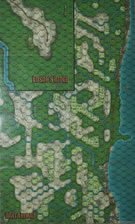| Author |
Schoenwulf
|
| Method |
Solo |
| Victor |
United States |
| Play Date |
2019-05-12 |
| Language |
English |
| Scenario |
Guad017
|
Battle Report: Mid-morning of September 26, 1942 saw a continuation of the fighting along the north stretch of the Matanikau River on Guadalcanal. Japanese survivors from Edson’s Ridge and troops from the 124th Infantry Regiment, 3rd Kure and 5th Yokosuka Landing Forces were situated south and east of the village by the river mouth within a 1K radius. Marines from the 1st Battalion, 7th Marine Regiment & 2nd Battalion, 5th Regiment, 1st Division were positioned on the large hill about 1.5K south of the village, while troops of the 1st Raider Battalion approached it from the east along the coastal track. The latter were rebuffed fairly quickly by Japanese fire from both village and jungle, but US air support had driven the Japanese from the ridge directly south of the village by 1130 hours. By 1330, the US controlled both small ridges located between the large hill and the village. A Japanese combined force of infantry and SNLF troops threatened the position on the south ridge but was quickly rebuffed an hour later. Even though American air support pretty much disappeared after noon, the US still held a well-enforced line in the jungle 0.7 K south of the ridge by nightfall. In a daring move, Lt. Dobson had taken a Marine platoon around the Japanese line and was 1.5 K west of the village by 2015. Hand-to-hand skirmishes continued south of the village into the night as disoriented units stumbled into one another in the dense jungle. Meanwhile, the Japanese mobilized a couple of platoons to track down Dobson’s unit, which was cut off behind enemy lines. At 2230, the Americans entered Matanikau village and found that it had been deserted by the Japanese due to Dobson’s breach of their perimeter line, but there were still active patrols in the surrounding jungle. At 0300 hours, an HMG platoon finally arrived to reinforce Dobson’s position. When dawn broke, the Americans had established a semi-circular line that went south from the village for about a Km and then east for 2 Km where it turned north terminating after a short distance in a firefight with the Dobson group. At 0800 hours, the Americans had two strong bases established, one southeast of the village and another 1.5-2 K southwest of it. At that point, the Japanese defenders were down to 3 SNLF, 3 Seaplane and 2 HMG platoons, all reduced, and a single mortar platoon. An hour later, American troops secured the village, with the remaining Japanese forces sequestered on a ridge 1 K west of the village. By noon, the mortar platoon was the only remaining Japanese unit; after holding out for almost five hours, the ridge was taken, and the five remaining Japanese leaders offered their swords. The next day Lt. Dobson was summoned by General Vandegrift, who explained that his action proved valuable by splitting the Japanese forces but also had great risk for the men that had to bail him out on the west flank.
Analysis: This 120-turn scenario covers over 24 hours of fighting with both hex control and step loss objectives for both sides. Both sides are also affected by disorientation the entire scenario, and disruption when moving during the night hours. The scenario was played using 4th Edition rules and the village rules from Kokoda Campaign for the town hex at the river mouth. The objective hexes for victory by either side are close, which forces intense fighting for ground control. Once the step loss count for victory is reached, that side may try to save its units, with the US having the added advantage of being able to withdraw units by shore evacuation. The Americans also can build stronger fire groups with the availability of 9FP HMG’s and 6FP infantry. In this playthrough, some very low-odds die rolls early in the game by both sides led to greater unit loss than expected, but both sides sheltered their remaining units accordingly and went to sniping for step losses. Two “new orders” events has eliminated the Japanese objective perimeter and raised the Japanese step loss victory level to 18, but the Americans still had scored 28 Japanese step losses to 6 for their side by nightfall on Turn 36, primarily due to the stronger fire-groups protected by jungle cover. At that point, the Japanese had nothing to lose in pursuing the three remaining US steps needed to achieve a draw. They attempted to isolate US units that had been separated and disrupted while trying to organize or bail out the isolated unit on the eastern side of the Japanese line. By dawn (Turn 75), the step loss count was 38-8 with the Japanese trying to get at least one more American step for a draw, pending any “new orders” events. The game was played out to 120 turns because of the possibility of such events that might have increased the American step loss level, but none were needed as the Japanese were unable to get another step. So, the game ended in an American victory with units well inside the Japanese perimeter and a low enough step loss count to avoid defeat that way. It was remarkable that the Americans needed almost 20 turns to take out a single mortar platoon that was under assault more than half the time. Step losses ended up at 56 for the Japanese and 8 for the Americans. Despite its length, the scenario is enjoyable as it really gives the feel of a chaotic jungle battle consistent with the actual encounter.
|







 Guad016
Guad016 






























